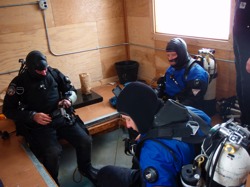GOLF 4-3-9 Antarctica Expedition 2008
Report Day 05 -- Friday 31 October 2008 -- Deploying Below the Sea Ice
GOLF 4-3-9 Antarctica Expedition 2008 |
| Daily Reports 1 | 2 | 3 | 4 | 5 | 8 | 9 | 10 | 13 | 14 | 15 | 16 | 20 | 25 | 27 | 30 | 35 | 37 | 38 | 42 |
.jpg)
This is our first field day today. We deployed our first experiment under the seasonal ice at Cape Evans (with the help from the USAP divers)! Going out on the sea ice sounds like a straightforward thing to do, but it is not. A snowmobile can take you far, very easily. While sea-ice is easy to travel on, it can also be treacherous, in particular near islands, moving glaciers and near the shore line (the sea-ice transition), where the ocean tides (here about a meter/three feet once a day) can bunch up a lot of ice. All this is relatively easily handled by experienced people when the visibility is good. However, when the sun is not out you cannot sea cracks very well and in a storm visibility gets very bad. Also, once you are out there, your snowmobile might break down and you don’t just walk home.

So we had to think of a lot of things during our shake-down day, trying to remember all we learned in our training (or rather remembered since it was "refresher" training). Gather food, survival bag, ECW gear, make some hot tea, hot water in a thermos, don’t forget your camera, ice probe, ice drill, GPS and not to mention any science gear. Then, check out a truck to bring it all down to the sea-ice transition where the snowmobiles are stored. You have to do much of all this when you are already in your ECW gear which makes you sweat. Sweating is not good in cold climates, such as before you start a long fast ride in the bitter cold wind on the sea ice. It is fine when you are moving around but as soon as you stop it is very easy to become chilled. We had a few delays, but we finally made it to the diving hut out at the Cape Evans wall, where a steep rock wall on land extends deep into the ocean. All of that right next to a glacier entering the ice. This is a beautiful place on land and under water. We picked this site because it is a favorite diving spot for the USAP divers, and where we have lots of volcanic rock from Mount Erebus exposed under water, in many ways resembling other places we work at, such as Loihi Seamount, part of the Hawaiian Islands, and at Vailulu’u Seamount, part of the Samoan Archipelago. Not to mention that this is a spectacular diving spot with unspoiled marine life, a spectacular glacier-ocean entry, and lots of curious seals, not so far away from their breeding grounds. This time the USAP diving team (Rob Robbins, Steve Rupp and Henry Kaiser) deployed our experiments in the freezing waters below the ice. Rob Robbins and Steve Rupp are the USAP dive services supervisors, and Henry Kaiser is a musician and film maker, notable for his production and underwater video coverage in Herzog’s movie Encounters at the End of the World. In a couple of years Hotel Sierra hopes to be diving himself to recover the samples and to assess the geological/environmental setting of this experiment. This will be possible only after intense training and renewing his science diving certification which is a demanding task.
The deployment went well, we have now the first sample deployed (77°38.407'S and 166° 31.118'E, at 133 feet), at the deepest depth divers can meaningfully do any work, and where light gets pretty dim, so photosynthesis does not play not much of a role.
As we were "saddling up" to get home, one of our snow mobiles would not start because its fuel pump was leaking fuel so we had to abandon it for now. We ended up riding home on one snowmobile. Not the same comfort as on the way out, but no problem. We stopped at the Erebus glacier tongue and explored a snow cave at the edge of the glacier ice. This is a spectacular little place, right at the edge of the glacier tongue. You can see the place on the 3-D perspective view of our area our map, right next to Turtle Rock!
| GOLF 4-3-9 Antarctica Expedition |